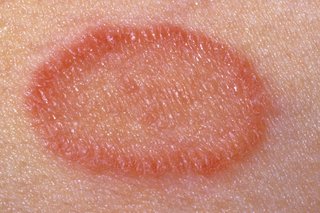Pityriasis rosea is a common skin condition. It causes a temporary rash of raised red scaly patches on the body.
It can affect anyone, but it's more common in older children and young adults aged 10 to 35.
Symptoms of pityriasis rosea
Feeling unwell
Some people feel unwell for a few days before they get the rash.
Symptoms of pityriasis rosea include:
- headache
- high temperature (when your body temperature is 38 degrees Celsius or higher)
- joint pain
The herald patch

The herald patch ranges in size from 2cm to 10cm. It can appear on your tummy, chest, back or neck. Less often it can appear on your face or scalp, or near your genitals.
Widespread rash

Up to 2 weeks after the herald patch appears, a more widespread rash develops. This rash may continue to spread over the following 2 to 6 weeks.
This rash is small, raised, scaly patches. They usually range in size up to 1.5cm. Most people get patches on their chest, back, tummy, neck, upper arms and upper thighs. The face is not usually affected.
The rash is not painful, but it can be itchy.
In light-skinned people the patches are usually a pinkish-red. In dark-skinned people the patches can be grey, dark brown or black.
Both the herald patch and rash usually last for 2 to 12 weeks. Sometimes they can last for up to 5 months.
After the rash has gone, you may have some darker or lighter areas of skin. These should return to normal within a few months and will not leave permanent scarring.
Causes pityriasis rosea
It is not known what causes pityriasis rosea. One theory is that the rash may be caused by a viral infection.
Pityriasis rosea is not contagious. It cannot be spread to other people by physical contact.
When to contact your GP
Contact your GP if you have an unexplained rash. They'll usually be able to confirm if it's pityriasis rosea. It might be another skin condition such as eczema, psoriasis or ringworm.
If your GP is not sure, they may refer you to a skin specialist (dermatologist).
Treating pityriasis rosea
Pityriasis rosea usually gets better without treatment within 12 weeks. Treatment is not needed unless you experience discomfort and itching.
Possible treatments for pityriasis rosea include:
- emollients – creams that moisturise and soothe the skin. Some can be used as soap because normal soap can irritate the rash.
- steroid creams or ointments – these can reduce swelling and relieve itching, and are prescribed by a GP
- antihistamines – if you're having trouble sleeping because of the itching, a GP may prescribe an antihistamine that will make you feel sleepy
- UVB light therapy – if other treatments do not work, you may be referred for UVB light therapy
Pityriasis versicolor
Pityriasis versicolor is another skin condition that can be confused with pityriasis rosea. The rash may look similar, but the conditions are different.
Pityriasis versicolor is caused by a yeast infection. It can be treated with antifungal medicines. These include antifungal creams and antifungal shampoos.
Content supplied by the NHS and adapted for Ireland by the HSE
